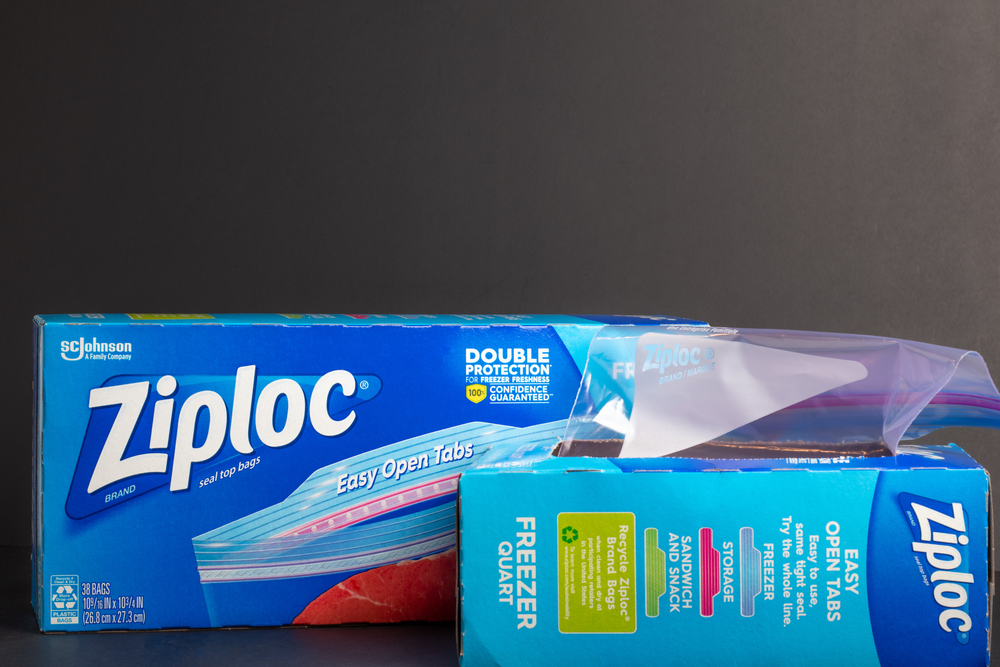You probably have a drawer full of them right now. Those familiar blue-and-clear Ziploc bags promise to keep your leftovers fresh and make meal prep a breeze.
But on April 25, 2025, a bombshell lawsuit filed in the Northern District of California raised alarming questions about what happens when you heat or freeze these everyday kitchen staples.
According to lawsuit claims, Ziploc bags and containers allegedly release millions of microscopic plastic particles into food when used exactly as directed.
Class plaintiffs also say that the plastic particles are so small that they can infiltrate human cells and accumulate in organs throughout the body.
Understanding How Ziploc Bags May Release Microplastics
Ziploc products are made from polyethylene and polypropylene - two plastic types dominating the food storage market. When these materials encounter heat or cold stress, they don't just sit there unchanged.
Heating releases particles
Research cited in lawsuit documents reveals that when people microwave a plastic container, it can release up to 4.22 million microplastic particles and 2.11 billion nanoplastic particles from just one square centimeter of surface area - all within three minutes of heating.
To put that in perspective, a standard Ziploc bag has hundreds of square centimeters of surface area in contact with your food, meaning temperature extremes make the problem exponentially worse.
Stages of release
The lead attorneys in this case have argued the following Ziploc plastic particle release stages:
- Refrigeration: Cold storage begins to alter the plastic's physical structure.
- Freezing: The plastic becomes brittle and more prone to fragmentation.
- Room temperature storage: Without any stress, polyethylene and polypropylene products may release thousands of microplastics per square centimeter as they thaw.
- Microwave reheating: Causes the highest release of particles, especially when heating frozen items.
Accumulation in vital organs
Bioaccumulation factors also add another layer of concern. Class plaintiffs claim the human body cannot efficiently eliminate these plastic particles. Instead, the chemicals build up over time, settling in various organs.
The lawsuit backs up this claim using a recent University of New Mexico study, where researchers documented a 50% increase in microplastic contamination within human brain tissue over eight years, examining postmortem samples from 52 individuals.

More On Microplastic Exposure Research
Documents in the lawsuit also cite multiple studies linking microplastic ingestion to serious health conditions.
Digestive System Damage: Microplastics alter gut microbiota composition, affecting everything from nutrient absorption to immune function.
Immune System Dysfunction: Polyethylene and polypropylene trigger inflammation and oxidative stress, weakening the body's natural defense mechanisms.
Cardiovascular Events: Patients with microplastics in their arterial plaque have significantly higher risks of heart attack, stroke, or death within 34 months compared to those without detectable particles.
Reproductive Health Concerns: Microplastics can cause "irreversible changes in the reproductive axis and central nervous system" following prenatal exposure.
Linda Cheslow’s Reason for Filing the Lawsuit
Santa Rosa, CA, resident Linda Cheslow became the face of this legal challenge after purchasing Ziploc Seal Top Freezer Bags at her local Costco. For decades, she had purchased gallon (38-count) and quart (54-count) sizes, spending $15-20 per box.
According to the complaint, Cheslow specifically relied on the “Microwave Safe” and “Freezer” labels when buying her freezer bags and believed the symbols meant the products were safe for everyday use without health risks.
The lawsuit emphasizes that she did not know the bags could release microplastics when used as directed and that she would not have purchased the products - or would have paid significantly less - had S.C. Johnson disclosed the alleged microplastic risks.
Which Ziploc Products are named in the Lawsuit?
The lawsuit against Ziploc maker S.C. Johnson specifically targets products bearing both "Microwave Safe" and "Freezer" designations.
Ziploc Freezer Bags - All Sizes:
- Pint/Small (20-count boxes)
- Quart/Medium (38-count and 54-count boxes)
- Gallon/Large (various count boxes)
These feature the distinctive blue "FREEZER" labeling and show the microwave-safe symbol on packaging.
Slider Freezer Bags:
- Quart/Medium with "Easy Open" design
- Gallon/Large featuring "Power Shield Technology"
The slider mechanism doesn't change the plastic composition - these bags contain the same polyethylene and polypropylene materials.
Slider Storage Bags:
- Quart/Medium (typically in red "STORAGE" packaging)
- Gallon/Large sizes
Even though marketed for storage rather than freezing, these products still carry microwave-safe claims.
Ziploc Containers:
- Square and rectangular shapes
- Various sizes from small to large
- Features "One Press Seal" technology
The controversy centers on the microwave safe symbol - that familiar wavy lines icon consumers have trusted for decades.
People suing S.C. Johnson allege this symbol creates false confidence, leading people to heat these products without understanding the potential for microplastic release.
Understanding the Class Action Structure
Class action attorneys have structured the lawsuit to maximize participation and potential remedies.
Class plaintiff definitions
- Nationwide Class includes all U.S. residents who purchased the listed Ziploc products for personal use during the applicable statute of limitations period. This broad definition could encompass millions of households.
- California Subclass specifically covers California residents who made purchases within four years before the filing date. California's stronger consumer protection laws provide additional legal avenues for these plaintiffs.
Legal claims asserted
- Unfair Competition Law Violations: S.C. Johnson gained an unfair market advantage by hiding product risks while competitors who disclosed similar issues lost sales.
- False Advertising Law Violations: Marketing products as "Microwave Safe" while allegedly knowing they release harmful particles constitutes deceptive advertising under California law.
- Consumer Legal Remedies Act Violations: Focuses on S.C. Johnson, representing products that had safety concerns they allegedly didn't possess.
- Unjust Enrichment: Company allegedly profited from premium pricing based on false safety claims, requiring them to return those ill-gotten gains.
In response to the lawsuit, S.C. Johnson has argued that "Ziploc products are safe when used as directed and that the lawsuit claims are without merit."
S.C. Johnson’s Official Position
The defendants in this case have firmly rejected the allegations in the lawsuit.
An S.C. Johnson spokesperson emphasized in June 2025 that microplastics have become pervasive throughout the environment - in food, water, and air from many sources and pointed to its longstanding commitment to product safety and environmental responsibility.
The company also claimed it has been actively working to raise awareness about plastic pollution, pushing for global plastic regulation, and investing in sustainable solutions.
Despite the lawsuit’s claims, S.C. Johnson has not announced any product recalls or labeling changes in response to the litigation.
A Watershed Moment for Consumer Protection
The Ziploc class action lawsuit represents more than a legal dispute between consumers and a corporation. It symbolizes a growing awareness of how everyday products impact long-term health.
Just as past generations learned about asbestos, lead paint, and cigarette dangers, we're discovering that convenience sometimes carries hidden costs.
Today, we're learning that the microscopic threats we couldn't see or measure twenty years ago now demand attention and action.
Frequently Asked Questions (FAQ)
You can continue using Ziploc products, but consider modifying your use. Avoid microwaving food in plastic bags or containers, and don't store hot food directly in plastic. According to the research cited in the lawsuit, the risk appears lower for cold storage and dry goods.
You're likely eligible if you purchased any of the listed Ziploc products (freezer bags, slider bags, or containers) for personal use during your state's statute of limitations period. The nationwide class includes all U.S. residents, while California residents may have additional claims under state law.
Class action settlements typically include refunds for purchases, coupons for future products, and sometimes cash payments. The exact amount depends on how many people file claims and the settlement terms. The lawsuit also seeks injunctive relief, which could force labeling changes.
Store brands often use similar polyethylene and polypropylene materials, so they likely pose comparable risks when microwaved or frozen. The lawsuit specifically targets Ziploc's marketing claims rather than unique product formulation issues.



Add Comment